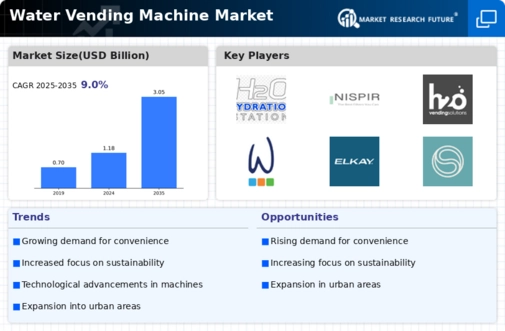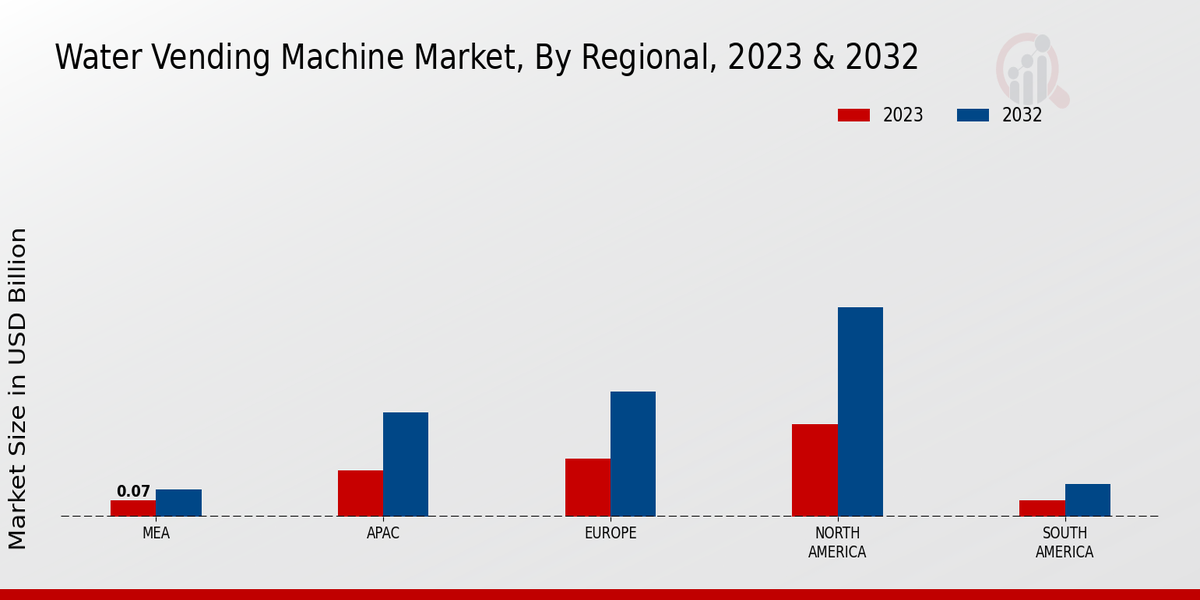Market Growth Projections
The Global Water Vending Machine Market Industry is poised for substantial growth, with projections indicating a market size of 1.18 USD Billion in 2024 and an anticipated increase to 3.05 USD Billion by 2035. This growth trajectory suggests a compound annual growth rate (CAGR) of 9.02% from 2025 to 2035. Such figures highlight the increasing reliance on water vending machines as a viable solution for clean drinking water in various settings. The market's expansion is likely to be driven by factors such as urbanization, technological advancements, and heightened consumer awareness regarding health and sustainability.
Health and Safety Regulations
Health and safety regulations play a crucial role in shaping the Global Water Vending Machine Market Industry. Stringent guidelines regarding water quality and hygiene standards necessitate the implementation of advanced purification technologies in vending machines. Compliance with these regulations not only ensures consumer safety but also enhances the credibility of vending machine operators. As awareness of waterborne diseases increases, consumers are more inclined to seek out reliable sources of clean water. This regulatory landscape is likely to drive market growth, as operators invest in high-quality machines that meet or exceed health standards, thereby fostering consumer trust and expanding market reach.
Rising Demand for Clean Drinking Water
The Global Water Vending Machine Market Industry is experiencing a notable increase in demand for clean drinking water, driven by growing health consciousness among consumers. As urban populations expand, the need for accessible and affordable water solutions becomes paramount. For instance, in 2024, the market is projected to reach 1.18 USD Billion, reflecting a shift towards healthier lifestyles. This trend is particularly evident in densely populated areas where traditional water supply systems may be inadequate. The convenience of water vending machines, which offer purified water on-the-go, aligns with consumer preferences for hygiene and quality, thus propelling market growth.
Environmental Sustainability Initiatives
The Global Water Vending Machine Market Industry is increasingly influenced by environmental sustainability initiatives. Governments and organizations worldwide are promoting the reduction of plastic waste, which has led to a surge in the adoption of water vending machines. These machines often encourage the use of refillable containers, thus minimizing single-use plastic consumption. As consumers become more environmentally aware, the demand for sustainable water solutions rises. This shift not only aligns with global sustainability goals but also enhances the market's appeal. The integration of eco-friendly practices within the water vending machine sector is likely to foster growth, as it resonates with the values of a growing segment of the population.
Increased Urbanization and Population Growth
Urbanization and population growth are pivotal factors driving the Global Water Vending Machine Market Industry. As more individuals migrate to urban centers, the demand for convenient access to clean water intensifies. This trend is particularly pronounced in developing countries, where infrastructure may lag behind population needs. The market's expansion is projected to reach 3.05 USD Billion by 2035, underscoring the necessity for innovative water solutions in urban environments. Water vending machines serve as a practical response to this challenge, providing immediate access to purified water in high-traffic areas such as parks, shopping centers, and transportation hubs, thereby addressing the needs of urban dwellers.
Technological Advancements in Water Purification
Technological innovations in water purification systems are significantly influencing the Global Water Vending Machine Market Industry. Advanced filtration technologies, such as reverse osmosis and UV purification, enhance the quality of water dispensed by vending machines. These improvements not only ensure compliance with health standards but also attract environmentally conscious consumers. As a result, the market is expected to grow at a CAGR of 9.02% from 2025 to 2035, indicating a robust future driven by technological enhancements. The integration of smart technology, such as contactless payment systems and real-time water quality monitoring, further elevates the consumer experience, making these machines more appealing.













